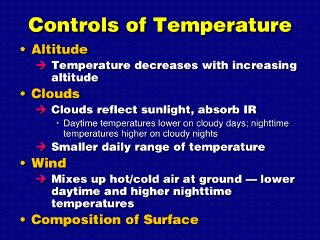 Clouds increase atmospheric albedo,
so daytime temperatures decrease due to the decreased absorption of sunlight
by the ground. The higher water vapor content in a cloud compared to the surrounding
air causes IR to be trapped, just as in the greenhouse
effect, during the night, so nighttime temperatures are warmer when it's
cloudy than when it's clear. This reduces the difference in temperature between
the daily minimum and maximum temperatures. We define the daily range of
temperature as the difference between the maximum and minimum temperatures
for one day, so this is reduced or moderated by the presence of clouds.
Clouds increase atmospheric albedo,
so daytime temperatures decrease due to the decreased absorption of sunlight
by the ground. The higher water vapor content in a cloud compared to the surrounding
air causes IR to be trapped, just as in the greenhouse
effect, during the night, so nighttime temperatures are warmer when it's
cloudy than when it's clear. This reduces the difference in temperature between
the daily minimum and maximum temperatures. We define the daily range of
temperature as the difference between the maximum and minimum temperatures
for one day, so this is reduced or moderated by the presence of clouds.
Winds have a tendency to mix
air vertically due to random turbulent motions in air flowing close to the ground.
So at night, when there is a thin layer of cold air at the ground,
the wind carries some of the cold air upward, mixing some of the warmer air
aloft down to the ground as a result, so the overall temperature near the ground
becomes higher. During the daytime, there will be a hot layer of air next to
the ground, and this is transported upward by the wind and replaced by cold
air from above, thus reducing the daytime temperature. The net result is similar
to that of having clouds around---the daily range of temperature is reduced.



 Clouds increase atmospheric albedo,
so daytime temperatures decrease due to the decreased absorption of sunlight
by the ground. The higher water vapor content in a cloud compared to the surrounding
air causes IR to be trapped, just as in the greenhouse
effect, during the night, so nighttime temperatures are warmer when it's
cloudy than when it's clear. This reduces the difference in temperature between
the daily minimum and maximum temperatures. We define the daily range of
temperature as the difference between the maximum and minimum temperatures
for one day, so this is reduced or moderated by the presence of clouds.
Clouds increase atmospheric albedo,
so daytime temperatures decrease due to the decreased absorption of sunlight
by the ground. The higher water vapor content in a cloud compared to the surrounding
air causes IR to be trapped, just as in the greenhouse
effect, during the night, so nighttime temperatures are warmer when it's
cloudy than when it's clear. This reduces the difference in temperature between
the daily minimum and maximum temperatures. We define the daily range of
temperature as the difference between the maximum and minimum temperatures
for one day, so this is reduced or moderated by the presence of clouds.